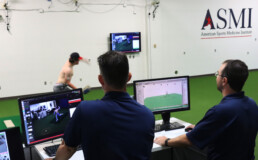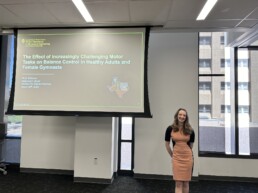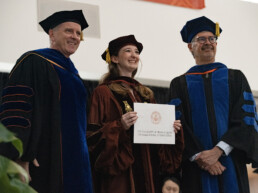At the highest levels, athletes and teams are embracing engineering to maximize performance and prevent injury. Texas Engineers are making a major impact in the surging biomechanics industry.
by Nat Levy
Ella Small knows how to make a big impression, at the doctor’s office and on the balance beam.
She won a national championship for UT’s gymnastics team in that event in 2023. She came close to a repeat win in 2024, just a few months before finishing her Ph.D. in mechanical engineering at the Cockrell School.
But the 27-year-old has paid the price for her achievements.
In middle school, she dealt with spondylosis — a condition that causes wear and tear on the spine. She’s suffered labral tears in both hips due to dislocations, as well as countless bumps, bruises and sprains. She may need both knees replaced before her 30th birthday.
I’m a walking textbook,
Small said. Every time I go to the doctor’s office, they bring in all the interns and the medical students to look at all the injuries I have.
Small is part of a growing group of Texas Engineering students and alumni dedicating their careers to advancing what our bodies are capable of using engineering principles. She took what she knew — pain and peak performance — to the growing field of biomechanics.
In her own words: Ella Small talks about her research, gymnastic career, injuries and more.
Biomechanics is the study of how the human body generates forces and motion. Knowing more about these forces can help people with motor impairments regain function. And this knowledge can serve as the backbone of new devices and technologies to encourage participation in daily activities. The field has entered popular culture in recent years because of advancements in sports science aimed at optimizing performance and preventing injury by equipping athletes with sensors to monitor every movement.
However, the competitive nature of sports means franchises determined to engineer a winning season keep their biomechanics operations top secret. Researchers at UT are exploring how to advance the discipline in a public way so that we all can understand why our bodies do what they do, and how we can keep them healthy.
“For all the energy and time we’ve put into medicine and understanding our bodies, there’s still so much we don’t know about the biomechanical processes behind everything we do on a daily basis.”
–Rick Neptune, professor, Walker Department of Mechanical Engineering and leader, Neuromuscular Biomechanics Lab.
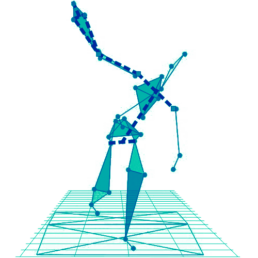
Play Ball
No sport has so eagerly implemented technological and mathematical advances like baseball — remember Moneyball? So, it’s no surprise baseball has embraced biomechanics.
The New York Yankees, perhaps the most storied franchise in American sports history, has invested heavily in the technology. One of Neptune’s former students, Lydia Brough (Ph.D. mechanical engineering 2022), is part of that operation as a performance science engineer.
Though she’s been a consistent runner and cyclist throughout her life, Brough has avoided major injuries. But, she has an engineer’s mindset and curiosity about the human body.
Brough came to UT after hearing about Neptune’s lab as an undergraduate at Penn State University. The group’s focus on blending hands-on experiments with modeling and simulation to give a holistic picture of the body and its movements appealed to her.
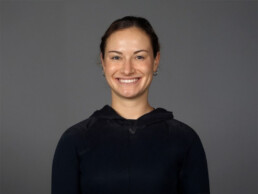
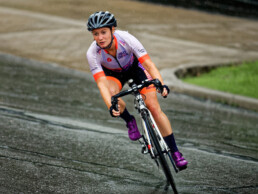
Lydia Brough is a runner and cyclist when she’s not working on biomechanics for the New York Yankees. Courtesy of Brough.
“I’ve always found the human body so interesting and unpredictable. Even though my research wasn’t about sports, it’s a great lens through which to examine the body.”
— Lydia Brough
Her research in Neptune’s lab focused on balance control in both young, healthy populations and among stroke patients. She drilled down on the complex relationship between the muscles crossing the ankle joint and balance control.
Any athlete in their late 30s, like the author of this piece, with the threat of an Achilles tear looming around every corner, is well aware of the importance of this complex web of muscles and tendons in the lower leg.
Like all things professional sports, teams’ secret sauce is very hush-hush, so Brough couldn’t divulge much about her work or the Yankees’ biomechanics unit. Generally, the group uses motion capture technology to monitor health and performance of their athletes.
The goal is to turn that into actionable insights for coaches and players.
If someone falls into a slump, we can look at the data and try and figure out if something has changed and needs to be corrected,
said Brough.
Brough and her team have access to a deluge of data, which can be a blessing and a curse. What’s meaningful, and what’s just noise?
The explosive growth of wearables and markerless motion capture technology allows today’s athletes to obtain data about their actual performance, a significant change from a more theoretical era when all this research took place in a lab.
Another source of valuable sports biomechanics data is the American Sports Medicine Institute (ASMI). Renowned orthopedic surgeon Dr. James Andrews founded the non-profit research institute in 1987, with a goal of improving the understanding, prevention and treatment of sports-related injuries through research and education.
For eight years, Cockrell alumnus Jon Slowik has been a biomechanist at ASMI. He currently oversees the motion analysis lab in Birmingham, Alabama, where he and his team collect data on athletes and calculate forces and loads on joints and other bodily structures. He also helps conduct cadaveric research in ASMI’s surgical skills lab and brings together findings from both labs using many of the modeling and simulation techniques he learned from Neptune.
ASMI also offers a sports medicine fellowship program, where doctors can learn cutting-edge surgical techniques and non-surgical treatments that can help athletes recover faster and more fully from injury.
ASMI helps pitchers avoid and recover from overuse. The institute worked closely with organizations such as Major League Baseball to develop a series of recommendations called Pitch Smart.
These recommendations — such as reducing the number of innings pitched in a year and building in multiple months of dedicated rest time yearly — aim to blunt increasing injury rates in young players. Tommy John surgery, a procedure that repairs the ulnar collateral ligament in the elbow, used to be exclusive to top major league pitchers who log hundreds of innings per year throwing against the best hitters in the world.
We are seeing higher and higher numbers of players having this surgery, many of them being high school age or even younger,
Slowik said. Much of the recent increase seems to be driven by an obsession with velocity. Analytics say the harder you throw, the more effective you are, and that has trickled down to all levels, with serious consequences.
Slowik took a winding path to ASMI. He received his bachelor’s degree in mechanical engineering from the Massachusetts Institute of Technology and worked in the aerospace industry for several years, focusing on communications satellites. However, he wanted to make a more direct impact by working with people to improve their lives.
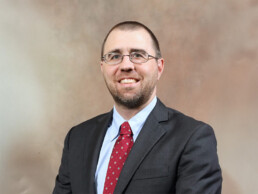
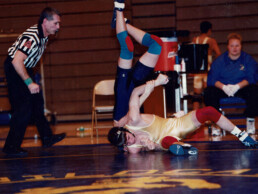
Jon Slowik wrestled in high school in Illinois and continued doing it for his first year of college.
“I was always interested in the design and movement of the human body, but I didn’t realize you could do that for a career."
— Jon Slowik
After learning about the field of biomechanics, his mind went to a close-to-home case. Slowik’s brother-in-law suffers from Charcot-Marie-Tooth disease, and he uses a manual wheelchair to get around and perform daily activities. Their relationship helped Slowik develop a greater understanding of all the difficulties related to life in a wheelchair. And it motivated him to study the biomechanics involved in wheelchair use and focus on the overuse injuries faced by those who operate them. He joined Neptune’s lab in pursuit of his Ph.D. and gained further real-world biomechanics expertise through a collaboration with Rancho Los Amigos Rehabilitation Center in California.
A former high school wrestler, and an avid Chicago sports fan, Slowik was excited to apply his biomechanics expertise to sports. Outside the lab, Slowik blends his work in sports biomechanics and his passion for improving the lives of wheelchair users through volunteer work at the Lakeshore Foundation, which provides opportunities for individuals with disability to live healthy lifestyles through physical activity, research, advocacy and health promotion.
Lakeshore is an amazing place, helping people with disabilities and all levels of athletic ability, from young children first learning about adaptive sports to U.S. Paralympians, for whom it is an official training site,
Slowik said. These are some of the most awe-inspiring athletes on the planet, and the loads they place on their bodies, especially their shoulders, when propelling their chairs and making athletic maneuvers, is unmatched. So, it’s an interesting challenge to figure out how to protect them from injury without hampering their performance.
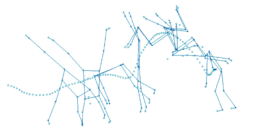
From the Beam to the Lab
Small, for most of her life, had a love-hate relationship with gymnastics. Her mother was also a high-level gymnast and didn’t want that life for her daughter. Nature beat nurture this time and Small fell in love with the sport at a young age.
Growing up in Atlanta, Small competed and also coached younger gymnasts. She even spent time in Russia, learning from top coaches there.
But by the time college entered her mind, Small was burnt out on the sport and wanted to stay as far away from gymnastics as possible. Her eventual undergraduate choice, Swarthmore College, didn’t have a gymnastics program at all, a point in its favor.
There, she studied physics but wanted something more practical.
I couldn’t spend the rest of my life looking at particles,
she said.
That led her to biomechanics. At UT, Small originally planned to focus on helping stroke patients, but the COVID-19 pandemic restricted the possibility of bringing vulnerable people into a lab for studies. Neptune encouraged Small to focus on what she knew best: gymnastics.
This advice opened a door that Small had closed, but not locked, years ago. Small zeroed in on the back handspring, a move as common to a 10-year-old gymnast as it is to Simone Biles. What she found was surprising: gymnasts naturally perform back handsprings in three different ways, and one is far better for the body than the others.
The optimal technique is called sequential flection,” Small said. “They keep their legs straight, bend their chest forward, and then they bend their knees and execute the flip. It’s actually really similar to a proper deadlift technique.
Small collected this data by analyzing more than 20 gymnasts of different ages and skill levels. These subjects visited the motion capture lab within Darrell K. Royal-Texas Memorial Stadium. The lab is rigged with a ring of cameras around the room, with force plates embedded in the floor. Subjects are outfitted with more than 50 sensors — which Small calls polka dots
— as well as electrodes that detect muscle activity.
These devices help the researchers create a digital twin of their subject that they can analyze.
In her research, Small found that her back handspring did not fall under the optimal technique. Her back bends significantly, which has led to spinal issues.
It’s successful; I stay on the beam and get a good score,
Small said. But it’s not optimal for the long-term health of a gymnast because it puts so much pressure on the spine.
Small will soon join Brough in Major League Baseball biomechanics, as she recently landed a job with the Pittsburgh Pirates as a biomechanist.
She continues to pursue her Ph.D. research and just recently published a new paper on it. By better understanding optimal movements, the hope is to prevent the injuries Small and countless other gymnasts have experienced.
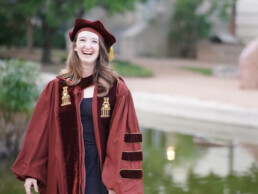
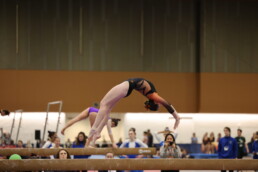
Ella Small got her Ph.D. in 2024, a year after winning a national championship in gymnastics. Courtesy of Small
“Gymnastics is a very intense sport that demands a ton of hours from these teenagers and wreaks havoc on their bodies. Other big sports have hundreds, if not thousands, of studies about injury and performance. For gymnastics, it’s less than 100. Anything we can do to make it safer; I would love to be able to see that.”
— Ella Small
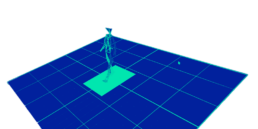
Like Teacher, Like Student
Like Small, Neptune draws on his athletic background and injury history in his work.
Growing up in California, Neptune was a competitive skier. He was also a two-time all-state running back on his football team in high school. Neptune’s team at Truckee High School won the state championship his junior year. An awkward hit led to a ruptured spleen for Neptune, ending his senior season.
He recovered and went on to play strong safety at the University of California, Davis, where he earned all-conference honors and went on to coach as a graduate assistant. But, a knee injury during a pickup basketball game ended his contact sports career.
However, that didn’t stop him; Neptune remains a competitive cyclist to this day.
Neptune became fascinated with the human body’s capabilities because of athletics. One of his first hands-on projects involved developing an optimized ski binding.
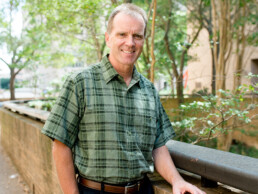
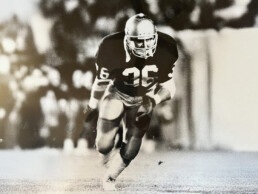
Rick Neptune won a California state championship in high school and went on to play at UC Davis. Courtesy of Neptune
“I always found it fun researching the things I enjoy doing, and that’s what I pass along to my students. You don’t want them working on something they don’t care about.”
— Rick Neptune
Now as a faculty member, Neptune works with people who have experienced strokes, limb amputations, spinal cord injuries and more. The hybrid approach of experimentation and simulation aims to estimate things that can’t be measured directly, such as joint contact forces. The goal is to better understand how these parts work together to power the human body, the same way a motor makes a car run.
Neptune recently received a pair of grants totaling $5.5 million to advance his research on the medical side of biomechanics. A $4 million grant from the Congressionally Directed Medical Research Program will support testing three modern, carbon fiber ankle-foot orthoses to help stroke survivors recover mobility and improve their quality of life. The other, a $1.5 million grant from the National Institutes of Health, focuses on developing stronger prosthetic devices to improve balance control for people who have undergone lower limb amputations.
One of the challenges in the field, especially when it comes to the athletic side of biomechanics, is the insular nature of the work. The competition is high stakes, so leagues and teams either develop, license or buy technology that becomes proprietary. So, the public literature in biomechanics for athletic performance is less than robust.
Neptune’s lab and other groups like ASMI are the exception, pushing biomechanics into the public sphere.
We are trying to advance the field of biomechanics and neuromotor control of human movement to help people know more about the body and apply it to those struggling with injuries or other conditions, Neptune said.
Better Than Ever
Biomechanics has a chance to help millions of people around the world, from those who are adjusting to severe medical challenges to elite athletes. Turns out, it also can help the people studying the subject.
Since completing her Ph.D. and learning about optimal gymnastics techniques, Small has reworked her training regimen entirely. The 27-year-old national champion is likely done competing, but she continues to do plenty of gymnastics. Introducing cross-training and more diverse workouts has helped Small feel as healthy as she has in years.
Ella Small defending her Ph.D. research and receiving her degree.
She’s also tried to recalibrate her back handspring technique to match the data she found in her research.
I’ve tried to change my technique to the optimal method. But it has not gone well,
Small said with a giggle. It’s a little too scary to try up on the beam.
KNOW A COURAGEOUS ENGINEER?
Help us find more engineers doing big things around the world.
